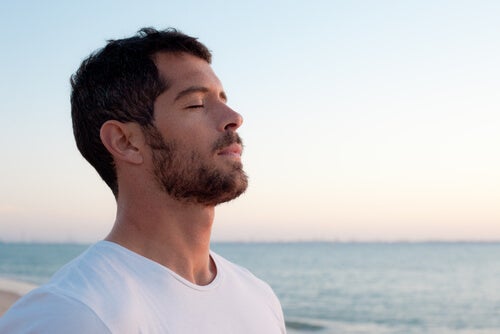Are You Aware of Your Own Breathing?

Breathing is synonymous with life. The act of breathing is part of our existence from our first breath at birth to the last breath at death. Although we breathe automatically, it’s also one of the basic physiological processes we have some control over. But how many times a day are you aware of your own breathing?
Becoming aware of breathing is the first step in learning to use it for your benefit. You can use it to repair your mind and immediately stop all the thoughts you’re trying to deal with at the same time, as well as that bothersome internal dialogue.
However, there’s much more to it than that. By becoming aware of your breathing, you can, in turn, manage and direct it.
Incorrect breathing can lead to fatigue, depression, or anxiety. Conscious breathing can solve these problems and give you a healthier physical and mental state. There are numerous conscious breathing techniques that can give you new control over your mind and over the modification of thoughts and emotional states.
These techniques are often used in therapy. Let’s take a look at some of them.

Becoming aware of your breathing: some guidelines
Your breathing varies depending on the activity you’re doing or the emotional state you’re in. When you start carrying out conscious breathing, the first effect is that you’ll be able to control the thoughts that can easily influence your emotions.
When you start to become conscious of your breathing and practice any of the techniques, it’s best not to do it for more than 30 minutes a day.
Conscious breathing is always carried out through the nose, both for inhaling and exhaling. When the technique requires slow breathing, this isn’t negotiable. People believe that high blood oxygen levels are healthy, but this isn’t the case.
The goal is to maintain proper cellular oxygenation and to ensure that the blood CO2 levels is adequate for normal vasodilatory functions.
This is what you can achieve with conscious breathing when you carry it out slowly. If not, then you’ll hyperventilate. The CO2 in your blood will decrease and the blood vessels will contract. This is the case with holotropic breathing. The latter must always be done with the help of a professional.
Slow abdominal breathing
If you observe your breathing, you’ll realize that, in many cases, the air you inhale only expands the upper part of the lungs. However, if you observe a baby, you’ll see that the air they inhale swells their tummy. Over time, we tend to lose that kind of deep, calm breathing. Recovering abdominal breathing is the goal of this technique.
When you make the air reach the abdomen, noticing how it swells, what you’re really doing is using all your lung capacity. You’re making the air reach the lower part of the lungs.
It’s very important to perform it slowly. Counting to five when inhaling and again five when exhaling is an adequate rhythm. It’s the simplest technique around to help you start becoming aware of your breathing, and it’s also recommended to reduce anxiety.
Retention techniques
With this technique, you should take a deep breath, hold the air in your lungs up to a count of 10, and then release the air very slowly. This technique is widely used to discharge tension.
Reverse retention breathing consists of doing ten exercises of slow breathing, and expelling at the eleventh exhalation all the air that you’re able to. After that, you should try to keep your lungs empty for as long as you can, after which you should inhale normally again.
You should repeat this exercise between 10 and 15 times. Experts also recommend it for insomnia.

Breathing rate increase technique
This technique has different variations, but it basically consists of achieving a breathing cycle of two seconds, one to inhale and one to exhale. People use it sporadically, and mainly in cases where they feel unenergized and require a vitality boost. You could say that it’s the respiratory equivalent of the stimulating effect of a cup of coffee.
A nice variant here is to perform this type of breathing at the same time as you mentally visualize that your laziness and apathy are expelled with each exhalation. People suffer from anxiety or high blood pressure should avoid this technique, because it increases the heart rate. We also recommend that, at first, you carry it out under supervision.
Breathing is synonymous with life. The act of breathing is part of our existence from our first breath at birth to the last breath at death. Although we breathe automatically, it’s also one of the basic physiological processes we have some control over. But how many times a day are you aware of your own breathing?
Becoming aware of breathing is the first step in learning to use it for your benefit. You can use it to repair your mind and immediately stop all the thoughts you’re trying to deal with at the same time, as well as that bothersome internal dialogue.
However, there’s much more to it than that. By becoming aware of your breathing, you can, in turn, manage and direct it.
Incorrect breathing can lead to fatigue, depression, or anxiety. Conscious breathing can solve these problems and give you a healthier physical and mental state. There are numerous conscious breathing techniques that can give you new control over your mind and over the modification of thoughts and emotional states.
These techniques are often used in therapy. Let’s take a look at some of them.

Becoming aware of your breathing: some guidelines
Your breathing varies depending on the activity you’re doing or the emotional state you’re in. When you start carrying out conscious breathing, the first effect is that you’ll be able to control the thoughts that can easily influence your emotions.
When you start to become conscious of your breathing and practice any of the techniques, it’s best not to do it for more than 30 minutes a day.
Conscious breathing is always carried out through the nose, both for inhaling and exhaling. When the technique requires slow breathing, this isn’t negotiable. People believe that high blood oxygen levels are healthy, but this isn’t the case.
The goal is to maintain proper cellular oxygenation and to ensure that the blood CO2 levels is adequate for normal vasodilatory functions.
This is what you can achieve with conscious breathing when you carry it out slowly. If not, then you’ll hyperventilate. The CO2 in your blood will decrease and the blood vessels will contract. This is the case with holotropic breathing. The latter must always be done with the help of a professional.
Slow abdominal breathing
If you observe your breathing, you’ll realize that, in many cases, the air you inhale only expands the upper part of the lungs. However, if you observe a baby, you’ll see that the air they inhale swells their tummy. Over time, we tend to lose that kind of deep, calm breathing. Recovering abdominal breathing is the goal of this technique.
When you make the air reach the abdomen, noticing how it swells, what you’re really doing is using all your lung capacity. You’re making the air reach the lower part of the lungs.
It’s very important to perform it slowly. Counting to five when inhaling and again five when exhaling is an adequate rhythm. It’s the simplest technique around to help you start becoming aware of your breathing, and it’s also recommended to reduce anxiety.
Retention techniques
With this technique, you should take a deep breath, hold the air in your lungs up to a count of 10, and then release the air very slowly. This technique is widely used to discharge tension.
Reverse retention breathing consists of doing ten exercises of slow breathing, and expelling at the eleventh exhalation all the air that you’re able to. After that, you should try to keep your lungs empty for as long as you can, after which you should inhale normally again.
You should repeat this exercise between 10 and 15 times. Experts also recommend it for insomnia.

Breathing rate increase technique
This technique has different variations, but it basically consists of achieving a breathing cycle of two seconds, one to inhale and one to exhale. People use it sporadically, and mainly in cases where they feel unenergized and require a vitality boost. You could say that it’s the respiratory equivalent of the stimulating effect of a cup of coffee.
A nice variant here is to perform this type of breathing at the same time as you mentally visualize that your laziness and apathy are expelled with each exhalation. People suffer from anxiety or high blood pressure should avoid this technique, because it increases the heart rate. We also recommend that, at first, you carry it out under supervision.
All cited sources were thoroughly reviewed by our team to ensure their quality, reliability, currency, and validity. The bibliography of this article was considered reliable and of academic or scientific accuracy.
- Boyes, Alice (2016) Breathing Techniques for Anxiety. Ways to relieve anxiety using breathing exercises. Psychology Today. Recuperado de https://www.psychologytoday.com/us/blog/in-practice/201607/breathing-techniques-anxiety
- Yokogawa, M., Kurebayashi, T., Ichimura, T., Nishino, M., Miaki, H., & Nakagawa, T. (2018). Comparison of two instructions for deep breathing exercise: non-specific and diaphragmatic breathing. Journal of physical therapy science, 30(4), 614–618. doi:10.1589/jpts.30.614
- Cho, H., Ryu, S., Noh, J., & Lee, J. (2016). The Effectiveness of Daily Mindful Breathing Practices on Test Anxiety of Students. PloS one, 11(10), e0164822. doi:10.1371/journal.pone.0164822
This text is provided for informational purposes only and does not replace consultation with a professional. If in doubt, consult your specialist.







